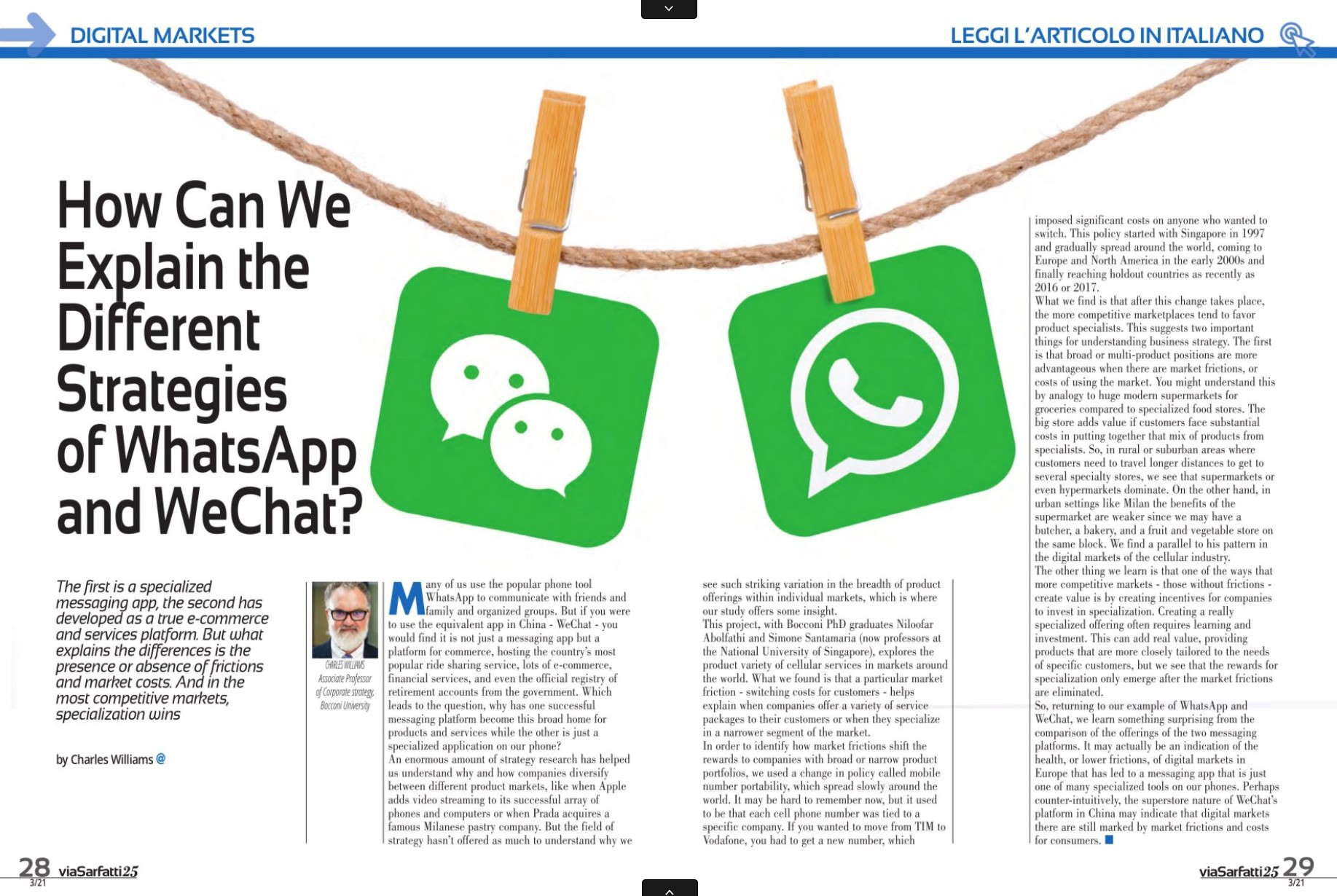
The Different Strategies of WhatsApp and WeChat
THE FIRST IS A SPECIALIZED MESSAGING APP, THE SECOND HAS DEVELOPED AS A TRUE ECOMMERCE AND SERVICES PLATFORM. BUT WHAT EXPLAINS THE DIFFERENCES IS THE PRESENCE OR ABSENCE OF FRICTIONS AND MARKET COSTS. AND IN THE MOST COMPETITIVE MARKETS, SPECIALIZATION WINSby Charles Williams, Associate Professor of Corporate Strategy, Bocconi University
Many of us use the popular phone tool WhatsApp to communicate with friends and family and organized groups. But if you were to use the equivalent app in China – WeChat – you would find it is not just a messaging app but a platform for commerce, hosting the country’s most popular ride sharing service, lots of e-commerce, financial services, and even the official registry of retirement accounts from the government. Which leads to the question, why has one successful messaging platform become this broad home for products and services while the other is just a specialized application on our phone?
An enormous amount of strategy research has helped us understand why and how companies diversify between different product markets, like when Apple adds video streaming to its successful array of phones and computers or when Prada acquires a famous Milanese pastry company. But the field of strategy hasn’t offered as much to understand why we see such striking variation in the breadth of product offerings within individual markets, which is where our study offers some insight.
This project, with Bocconi PhD graduates Niloofar Abolfathi and Simone Santamaria (now professors at the National University of Singapore), explores the product variety of cellular services in markets around the world. What we found is that a particular market friction – switching costs for customers – helps explain when companies offer a variety of service packages to their customers or when they specialize in a narrower segment of the market.
In order to identify how market frictions shift the rewards to companies with broad or narrow product portfolios, we used a change in policy called mobile number portability, which spread slowly around the world. It may be hard to remember now, but it used to be that each cell phone number was tied to a specific company. If you wanted to move from TIM to Vodafone, you had to get a new number, which imposed significant costs on anyone who wanted to switch. This policy started with Singapore in 1997 and gradually spread around the world, coming to Europe and North America in the early 2000s and finally reaching holdout countries as recently as 2016 or 2017.
What we find is that after this change takes place, the more competitive marketplaces tend to favor product specialists. This suggests two important things for understanding business strategy. The first is that broad or multi-product positions are more advantageous when there are market frictions, or costs of using the market. You might understand this by analogy to huge modern supermarkets for groceries compared to specialized food stores.
The big store adds value if customers face substantial costs in putting together that mix of products from specialists. So, in rural or suburban areas where customers need to travel longer distances to get to several specialty stores, we see that supermarkets or even hypermarkets dominate. On the other hand, in urban settings like Milan the benefits of the supermarket are weaker since we may have a butcher, a bakery, and a fruit and vegetable store on the same block. We find a parallel to his pattern in the digital markets of the cellular industry.
The other thing we learn is that one of the ways that more competitive markets – those without frictions – create value is by creating incentives for companies to invest in specialization. Creating a really specialized offering often requires learning and investment. This can add real value, providing products that are more closely tailored to the needs of specific customers, but we see that the rewards for specialization only emerge after the market frictions are eliminated.
So, returning to our example of WhatsApp and WeChat, we learn something surprising from the comparison of the offerings of the two messaging platforms. It may actually be an indication of the health, or lower frictions, of digital markets in Europe that has led to a messaging app that is just one of many specialized tools on our phones. Perhaps counter-intuitively, the superstore nature of WeChat’s platform in China may indicate that digital markets there are still marked by market frictions and costs for consumers.
Read the article in the magazine viaSarfatti25

